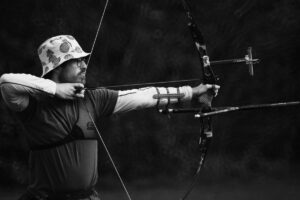In your quest to become a skilled archer, it’s crucial to understand the common archery injuries.
These injuries include tendinitis, strains and sprains, blisters and calluses, and string slaps.
Contents (Jump to Topic)
ToggleAccording to archery injury statistics, these injuries often result from repetitive motions, incorrect techniques, or overuse.
For instance, tendinitis is typically caused by continuous strain on your shoulders, elbows, and wrists.
Strains and sprains often stem from poor posture or improper form. Blisters and calluses result from extended bow use, while string slap, which results in skin discoloration and bruising, is common among archers due to poor posture or loose clothing.
Injury Prevention Techniques
Adopting specific injury prevention techniques can significantly reduce your risk of archery injuries.
Preventing injuries starts with a proper warm-up, including light cardio and stretching exercises to prepare your muscles for the task ahead.
Gradual progression in your training also plays a crucial role in injury prevention; start with lower draw weight and increase as your strength improves.
Proper technique is equally important in preventing injuries.
Avoid over-drawing, maintain the correct stance and footing, and listen to your body, taking necessary breaks to avoid overuse.
Appropriate safety measures such as arm guards, finger tabs, or gloves can also help prevent common injuries.
Regular equipment checks and maintenance are also crucial safety measures. Remember, safety should always be your top priority in archery.
Extra Tips for Injury Avoidance
Besides following proper technique and safety measures, there are additional steps you can take to minimize your risk of injuries in archery.
Choosing the right equipment is crucial. It should match your skill level and body size to prevent undue strain.
Regularly inspect your gear for any damages that could lead to mishaps.
Never underestimate the importance of rest and recovery. Overtraining leads to fatigue, making you more prone to accidents.
Listen to your body and take breaks when necessary.
The Importance of Gradual Progression
One might think archery is a sport you can dive headfirst into. However, it’s crucial to progress gradually to avoid injuries.
Jumping in too quickly, especially without the right equipment, can lead to strains, sprains, or tendinitis.
It’s better to start with lower draw weight and shorter draw length, then gradually increase as your strength and technique improve.
This approach helps your body adapt to the new physical demands, reducing the risk of overuse injuries.
Cross-training also plays a pivotal role here. Incorporating strength training, swimming, or yoga into your regimen can help build the necessary muscle groups for archery.
The benefits of cross-training include improved endurance, flexibility, and overall injury prevention.
Warm-up Procedures for Safety: Prepare to Win
Before you even nock an arrow, it’s crucial to warm up your muscles to prevent injuries properly.
Preventing muscle strain begins with a routine of light cardio, such as jogging in place, to increase your heart rate and blood flow to your muscles.
Following cardio, the importance of stretching can’t be overstated. This prepares your shoulders, back, and arms – the primary muscles used in archery – for the activity ahead.
Focus on gentle, controlled movements. Never bounce or force a stretch, as this can lead to injury.
Mastering Proper Archery Technique
Now that you’re warmed up, it’s time to master the proper archery technique to safeguard against injuries.
The first step is to undergo an analysis of your archery technique. This involves thoroughly examining your stance, grip, draw, aim, and release.
Focus on maintaining a straight, relaxed posture, a firm but not tight grip, and a smooth, controlled draw and release.
Next, gradually progress to advanced shooting techniques. These require a high level of skill, precision, and discipline.
Recognizing and Responding to Pain
As an archer, you’ll encounter various types of discomfort and pain, but understanding how to recognize and respond to these signals is your first defense against serious injuries.
Recognizing pain early is crucial.
Sharp, persistent, or worsening pain should never be ignored. It’s your body’s way of telling you that something’s wrong.
Pay special attention to pain in your shoulders, elbows, or wrists, common sites for archery-related injuries.
When pain strikes, don’t just grit your teeth and continue.
Employ pain management techniques like resting the affected area, applying ice or heat, and taking over-the-counter pain relievers.
If pain persists, seek professional medical advice.
Before you go…
Remember, archery is about precision and focus, not pain. Avoid common injuries like tendinitis, strains, blisters, and calluses.
Use the right equipment, progress gradually, and master the correct technique.
Always warm up properly before you start. Listen to your body and respond promptly to any pain.
Stay safe and happy shooting!






